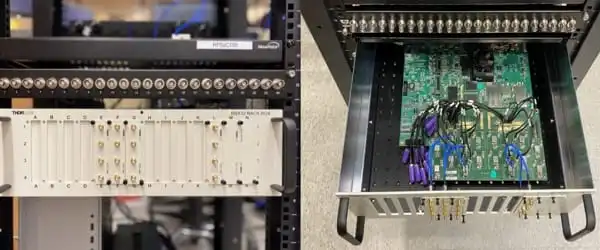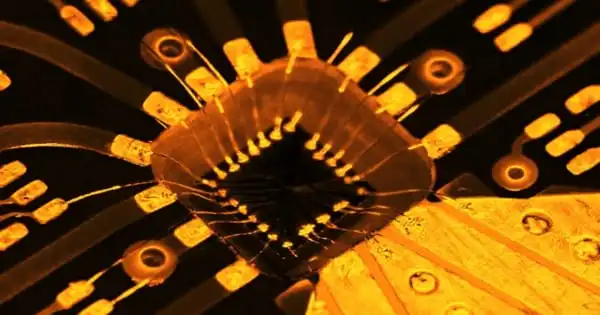A novel control and readout electronics alternative for quantum computing experiments has been developed, which will greatly boost performance while replacing cumbersome and expensive equipment. Bridging the communication gap between the classical and quantum worlds is a rather substantial difficulty when constructing a next-generation quantum computer. Existing systems are difficult and expensive, and such computers require specialized control and readout devices to communicate back and forth between the human operator and the quantum computer’s languages.
However, a new control and readout electronics system are known as the Quantum Instrumentation Control Kit, or QICK, developed by engineers at the US Department of Energy’s Fermi National Accelerator Laboratory has proven to significantly improve quantum computer performance while lowering control equipment costs.
“The Quantum Instrumentation Control Kit is an excellent example of US investment in joint quantum technology research with partnerships between industry, academia, and government to accelerate pre-competitive quantum research and development technologies,” said Harriet Kung, DOE deputy director for science programs and acting associate director of science for high-energy physics.
A team of Fermilab engineers led by senior principle engineer Gustavo Cancelo collaborated with the University of Chicago to construct and test a field-programmable gate array (FPGA) controller for quantum computing experiments. The University of Chicago’s lab that assisted with specifications and verification on real hardware was supervised by David Schuster, a physicist.
“This is exactly the kind of project that brings together the strengths of a national laboratory and a university,” Schuster said. “There is a definite demand for an open-source control hardware environment, and the quantum community is quickly adopting it.”
Engineers working on quantum computers face the difficult task of bridging the seemingly irreconcilable worlds of quantum and conventional computers. Quantum computers are based on quantum mechanics’ counterintuitive, probabilistic rules that govern the tiny universe, allowing them to execute calculations that regular computers cannot. Because people live in the macroscopic visible world ruled by classical physics, control and readout electronics serve as the translator between these two realms.
“We are designing a general instrument for a large variety of qubits, hoping to cover those that will be designed six months or a year from now. With our control and readout electronics, you can achieve functionality and performance that is hard or impossible to do with commercial equipment.
Harriet Kung
Control electronics employ classical world signals as instructions for the computer’s quantum bits, or qubits, whilst readout electronics measure the states of the qubits and transmit that information back to the classical world.
Superconducting circuits are used as qubits in one prospective quantum computer technology. Most control and readout systems for superconducting quantum computers now use off-the-shelf commercial technology that is not tailored to the task. As a result, researchers are frequently required to connect a dozen or more pricey components. The cost per qubit can soon reach tens of thousands of dollars, and the vast size of these devices adds to the complexity.
Despite recent technological advancements, qubits have a relatively short lifetime, often a fraction of a millisecond, after which they cause mistakes. “When working with qubits, time is of the essence. Classical electronics takes time to respond to qubits, limiting computer performance” Cancelo stated.
The success of a control and readout system is dependent on its turnaround time, just as the effectiveness of an interpreter is dependent on speedy communication. A huge system comprised of several modules also entails lengthy turnaround times.
Cancelo and his Fermilab team devised a compact control and readout system to overcome this issue. The team packed the power of an entire rack of equipment into a single circuit board no bigger than a laptop. The new technology is specialized, yet it is adaptable enough to work with a wide range of superconducting qubit designs.

“We are designing a general instrument for a large variety of qubits, hoping to cover those that will be designed six months or a year from now,” Cancelo said. “With our control and readout electronics, you can achieve functionality and performance that is hard or impossible to do with commercial equipment.”
Microwave pulses – radio waves at frequencies similar to those used to carry mobile phone calls and heat microwave dinners – are used for qubit control and readout. The Fermilab team’s radio frequency (RF) board has around 200 parts, including mixers to alter frequencies, filters to remove unwanted frequencies, amplifiers and attenuators to adjust signal volume, and switches to turn signals on and off. The board also includes a low-frequency control for tuning specific qubit characteristics. Together with a commercial field-programmable gate array, or FPGA, board, which serves as the computer’s “brains,” the RF board supplies everything scientists need to properly interface with the quantum realm.
The two small boards are around ten times less expensive to create than traditional systems. They can control eight qubits in their most basic arrangement. The integration of all RF components into a single board enables faster, more precise operation, as well as real-time feedback and error correction.
“You need to inject signals that are very, very rapid and very, very brief,” said team member Fermilab engineer Leandro Stefanazzi. “If you don’t properly regulate both the frequency and length of these signals, your qubit won’t function the way you want.”
The RF board and layout took about six months to design and provided significant challenges: adjacent circuit elements had to match perfectly so that signals traveled smoothly without bouncing and interfering with each other. Furthermore, the engineers had to avoid configurations that might take up stray radio signals from sources like as cell phones and WiFi. They did simulations along the way to ensure they were on the right route.
The design is now ready for fabrication and assembly, with operational RF boards expected this summer. The Fermilab engineers tested their concepts with the University of Chicago throughout the process. The new RF board is ideal for researchers like Schuster who seek to make fundamental advances in quantum computing using a wide variety of quantum computer architectures and devices.
“I frequently joke that this one board has the potential to replace practically all of the test equipment that I have in my lab,” Schuster said. “It’s tremendously rewarding for us to collaborate with individuals who can make electronics work at that level.”
The new system is simple to scale. A single RF board might control up to 80 qubits by frequency multiplexing qubit controls, which is akin to sending several phone conversations over the same wire. Several dozen boards could be joined together and synced to the same clock as part of bigger quantum computers due to their modest size. Cancelo and his colleagues revealed their innovative system in a report that appeared recently in the AIP Review of Scientific Instruments.
The Fermilab engineering team has taken advantage of a new commercial FPGA chip, the first to integrate digital-to-analog and analog-to-digital converters directly into the board. It substantially speeds up the process of creating the interface between the FPGA and RF boards, which would have taken months without it. To improve future versions of its control and readout system, the team has started designing its own FPGA hardware.
A low-cost variant of the hardware is now solely accessible for educational use at universities. “Because of its inexpensive cost, it enables smaller organizations to have powerful quantum control without paying hundreds of thousands of dollars,” Cancelo explained.
“From a scientific standpoint, we see one of the decade’s hottest subjects in physics as an opportunity,” he added. “From a technical standpoint, what I appreciate is that several disciplines of electrical engineering must work together to effectively complete this project.”





